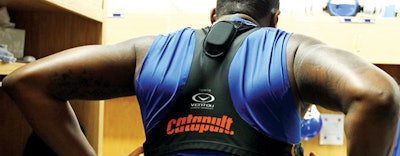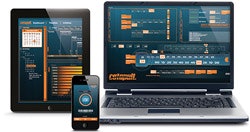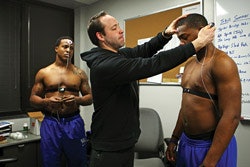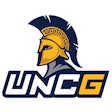
"Imagine driving a Formula One vehicle and not having a dashboard to know how that engine is performing," says Gary McCoy, applied sports scientist for Catapult USA, whose Australian-based parent company markets the athlete monitoring system that has gained unparalleled traction this year in American professional and collegiate sports. "It's the same with athletes. If you don't have the information readily available, it's very difficult to know what on-field performance truly looks like. And that's really what we provide through our technology - a dashboard that provides insight into athlete performance."

A computer-mouse-sized device weighing little more than an ounce fits into the back of a jersey, a separate undergarment or even shoulder pads at the base of the athlete's neck. The device employs gyroscopes, accelerometers, magnetometers and GPS systems to provide upwards of 100 data points per second as to what's happening - as McCoy puts it - "onboard the athlete." It's technology born of the Australian Institute of Sport and now approaching two decades in development and application.
"One of the more liberating measures that comes of this is something that we call player load," McCoy says. "We measure all the different movements an athlete makes in practice - acceleration, deceleration, jumps, changes of direction. All those metrics are scored as a single number, so a strength and conditioning coach or a football coach can turn around and say, 'Gee, that was a tough practice,' or ask, 'Was it an easy practice?' We actually take the subjectivity out."
From there, coaches can prescribe a data-driven action plan.
"The problem is that strength coaches are designing training programs for football and other sports with no concept of what players are actually doing on the field," says Erik Korem, high performance coach at the University of Kentucky, the only Southeastern Conference school to employ that specific job title. "Most don't start with a question: 'What do they do?' They start with solutions: 'We're going to do these running drills. We're going to lift these types of weights.' What happens is you start developing an inefficient athlete who's not prepared to physically perform what he's asked to perform on the field. By collecting this data, I was able to start saying, 'Okay, coach, this is what a quarterback actually does, and here's how we're going to train him to match the demands of the game.' "

250+ Exhibitors & 190 Educational Sessions | abshow.com.
Such information allows for performance comparisons among athletes, but also indicates when recovery time is necessary for each individual. "We break down the physiological costs of deceleration and those really hard changes of direction," McCoy says. "Just like the shock absorbers in a car, they take a toll on the body, and all of that load bearing on the musculoskeletal system answers the 'Was it a hard practice?' question and provides a sense of what recovery someone has to have."
This is seen as critical to preventing athlete injury and perhaps even extending playing careers. "Are we exceeding game parameters in practice? Are we doing too much? Are we doing too little?" asks Korem, who gleans answers to such questions from Catapult's software algorithms. "Then we can start actually affecting football, which is what we want to do. We want to affect the way that we practice, the way that we train, so that we're not underdoing it or overdoing it, which can lead to injuries. It can also lead to guys not being able to perform at their optimum on game day, and instead leave their best performances on a Tuesday practice field."
Return-to-play considerations following injury become less subjective, as well. Catapult monitored the rehabilitation of a prominent basketball player who had sustained a left ACL injury. Athletic trainers thought the athlete was ready to return, but the data revealed a 30 percent deficit in his ability to move to his right. "If they had put him back out on the floor, the opportunity for secondary injury would have been magnified," McCoy contends.
Some athlete weaknesses are there all along. McCoy visited an NFL training camp this summer and noticed a significant discrepancy in the lateral movement of the team's center. "Eighty percent of his moves were in one direction and only 20 percent of his moves were to the other direction," McCoy recalls. "And a lot of his injury history was built around the gross asymmetry that this athlete has developed. Because a functional view of the athlete's asymmetry is now available, the team is starting to change the way it trains that individual."
Tactics can also be altered. That same NFL team had a wide receiver whose data indicated that he could accelerate three times as fast to his right compared to his left. Says McCoy, "The head coach looked at me and goes, 'We've been lining him up on the wrong side of the field for five years.' "

CULTURE SHIFT McCoy points out that the NBA and NFL have been the most willing adaptors of the new sports science. American football teams invest $100,000 in the Catapult system, on average, with basketball's smaller rosters costing less. Monthly per-device subscriptions are now available, as well.
At least eight NBA teams will be using the Catapult device this year, and the NFL sent a memo to teams Aug. 1 stating that the league will "require players to wear non-obtrusive tracking devices in select practices and games" and that likely all players will be required to wear them "at some point over the next few seasons." (UK's Korem predicts athlete tracking will be league-wide in the NFL within two years.) As Catapult cofounder Shaun Holthouse told Forbes in May, "We want to feel we have fundamentally changed elite sport for the better."
Professional baseball, meanwhile, appears to be well behind the curve. "There's no sport science in baseball whatsoever. The old adage 'We've always done it this way' prevails," says McCoy, providing one example: "So many Major League Baseball teams have their pitchers perform squats. They think squats make the legs strong, and the legs need to be strong if you're going to pitch. The actual sequence of the squat is detrimental to a pitcher's stride length, and stride length and torso rotation equal velocity. There's no reason a pitcher should ever do a squat in his entire life."
For pitching coaches who want to toss the old methodology, McCoy offers this advice: "Change your culture. You have to have a sports science culture, not a strength and conditioning culture."
So far, the United States as a whole has lagged behind much of the world in terms of making that culture change. As of this writing, Catapult's website listed 42 U.S. clients (including 13 NCAA teams), compared to 72 in Australia and 66 in the United Kingdom. The website of GPSports, an athlete-tracking competitor, lists one American client (Baylor University) and 106 outside the U.S. "There are 300 million people in this country, and when one athlete falls down, there's another guy just as good ready to go behind him," McCoy says. "That doesn't occur internationally, especially in Australia, with such a small population. If we find an athlete who's good enough, we have to do everything we can to support him and keep him at that highest level possible." The U.S. appears poised to make an attitude adjustment. The day AB spoke to McCoy, he had received calls from two NFL teams, one NBA team and four NCAA Division I football programs.
Kentucky's program, which adopted athlete tracking upon Korem's arrival last December, is still seasons away from reaping the technology's full benefits on the field, the coach admits. But the Wildcats are no longer training blindfolded. "The idea of having periodized training programs in which everything is laid out for a full year is dead," Korem says. "You have to have a plan, then based off of the internal and the external costs of training you have to adapt that plan on a daily basis. Until we get to that point as a U.S. culture, we're going to continue to see the things that plague us - athletes getting injured, reduced professional careers, great high school athletes who disappear at the college level. Here at UK, we want to make sure the athletes we bring in are developed to their maximum potential - whatever that potential is."
Vital Signs

Cars come equipped with an engine temperature gauge, but the ability to measure whether or not an athlete is overheating is something that's still on the Catapult drawing board, according to Catapult USA applied sports scientist Gary McCoy, who says surface temperature is an insufficient indicator and gathering core temperature data is more invasive and thus impractical. (At least one rival product, the Zephyr PMS Training ECHO, estimates core temperature.) For now, the Catapult dashboard can integrate Polar heart rate monitoring data, provided the athlete is wearing a Polar T31 transmitter. Says McCoy, "Heart rate is a good tachometer of what's going on with the metabolic system and the cardiovascular system."
Can so much information be considered too much? McCoy points to one warm-weather NFL team that opts not to monitor players' heart rates. "It's as though they feel the more information on those athletes that's being exposed, the more liability shifts to the team itself, the strength and conditioning staff and those who are monitoring the players," McCoy says. "Wow! Okay. Player safety isn't the number-one factor that's involved here; it's potential legal exposure." - P.S.
Efficient Engines

One of the biggest surprises for University of Kentucky high performance coach Erik Korem when he began tracking athlete data during his days at Florida State is just how little football players actually work during games. "A significant portion of the game is just walking and jogging," says Korem, who quickly realized that traditional approaches to football conditioning are "way off."
"The game is aerobic and alactic, and the industry trains guys in a very lactic environment," Korem says. "The very nature of conditioning in a lactic environment reduces maximal outputs. It creates an inefficient engine. The heart gets used to operating at higher heart rates, so it almost gets agitated. It immediately skips to these extreme heart rates instead of allowing the aerobic system to replenish. If the aerobic system is more powerful, then the heart rate doesn't get as high, and you have a more efficient engine. You basically have a V-8 that's extremely fuel-efficient, instead of having a V-8 that guzzles a lot of gasoline and runs out of gas real fast." - P.S.





































